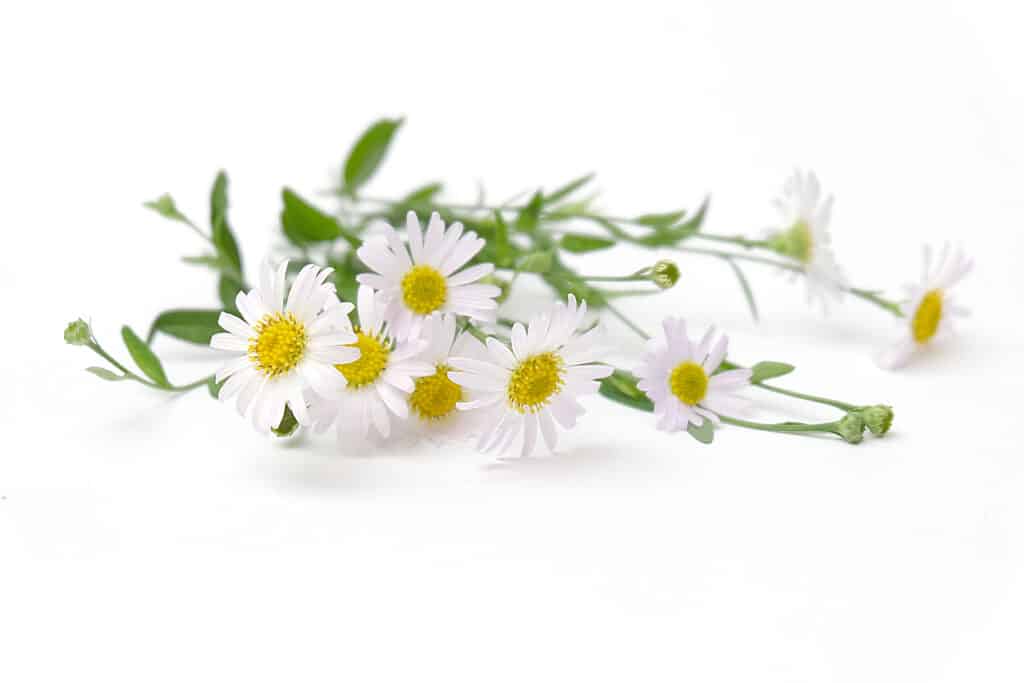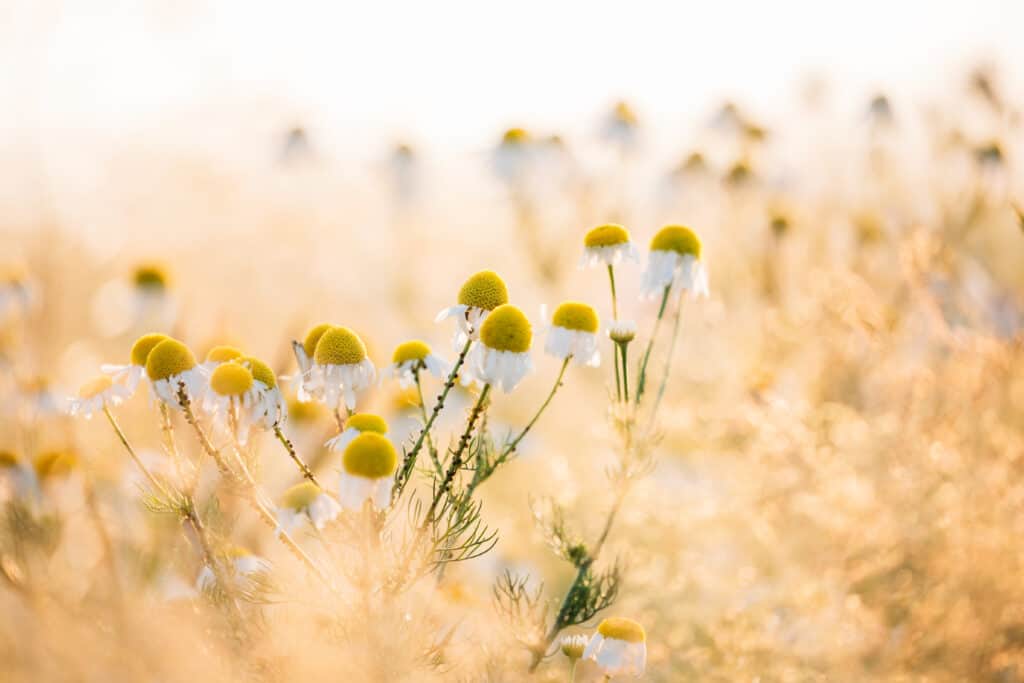Chamomile has long been one of the most popular herbs and is known for its calming powers. German and Roman chamomile are both flowering plants that are widely cultivated around the world. However, despite sharing the name “chamomile” and having an incredibly similar appearance, they are not entirely the same. So join us as we dive in and discover everything you need to know about German chamomile vs. Roman chamomile – including their classification, size, appearance, hardiness, and scent!
Comparing Roman Chamomile vs. German Chamomile
| Roman Chamomile | German Chamomile | |
|---|---|---|
| Species | Chamaemelum nobile | Matricaria chamomilla |
| Alternative Names | Anthemis nobilis, English chamomile, ground apple, mother’s daisy, whig plant | Matricaria recutita, Hungarian chamomile, blue chamomile, wild chamomile, scented mayweed |
| Size | Up to 1 foot | Up to 2 feet |
| Perannial or Annual | Perennial | Annual |
| Growth Style | Low growing & spreading | Upright |
| Stems | Hairy & branching | Smooth & single |
| Leaves | Greyish-green, feathery | Light green, fern-like |
| Flowers | Several flowers on each stem, rounded central discs | Single flower on each stem, hollow central cone |
| Cold Tolerance | Zones 4 to 11 | Zones 4 to 9 |
| Scent | Light apple | Sweet straw |
| Essential Oil Color | Clear | Blue |
The 6 Key Differences Between German Chamomile and Roman Chamomile

Chamomile flowers contain essential oils.
©Ohhlanla/Shutterstock.com
The main difference between German and Roman chamomile is their size and style of growth. Roman chamomile is low-growing and branches out, while German chamomile grows upright on single stems. The other major difference between these plants is that one is annual while the other is perennial. Additionally, they have slightly different leaves and flowers and contain different concentrations of essential oil.
German Chamomile vs. Roman Chamomile: Classification
Both German and Roman chamomile are members of the Asteraceae family, which is commonly known as the sunflower family. However, they are actually from different genera. German chamomile is a member of the Matricaria genus, which is comprised of approximately 130 different species. Plants in this genus are native to Asia, Africa, Europe, and the Americas, although they have been introduced elsewhere too.
Roman chamomile is a member of the Chamaemelum genus which is comprised of only two species – Roman chamomile and dusky dogfennel. Members of Chamaemelum are typically native to Europe but have been widely introduced around the world.
German Chamomile vs. Roman Chamomile: Size

Roman chamomile is a low-growing flower.
©Grisha Bruev/Shutterstock.com
The first noticeable difference between German and Roman chamomile is the size of the two plants. Roman chamomile is a low-growing plant that reaches no higher than 1 foot. It spreads across the ground rather than growing tall and can grow into a thick carpet, making it an excellent choice as ground cover in gardens. However, German chamomile has an upright growth style and typically reaches 2 feet tall.
German Chamomile vs. Roman Chamomile: Perennial or Annual
One of the main differences between German and Roman chamomile is that one is annual while the other is perennial. As perennial, Roman chamomile continually regrows every year. However, as an annual plant, German chamomile has to be grown from a seed every year. Despite this, it readily self-seeds so grows back yearly which is why it can often be mistaken for the perennial Roman chamomile..
German Chamomile vs. Roman Chamomile: Leaves

The leaves of both types of chamomile make a great tea.
©Africa Studio/Shutterstock.com
German chamomile has light green leaves, which tend to have a fern-like appearance. However, Roman chamomile typically has greyish-green leaves, which are thicker and flatter than those of German chamomile. The leaves of both are often used to brew a soothing chamomile tea. Also, they both produce the essential oil chamazulene (although German chamomile produces it in a higher concentration).
German Chamomile vs. Roman Chamomile: Flowers
Although both Roman and German chamomile flowers have white petals and yellow centers, they are not actually quite the same. For a start, the flowers on Roman chamomile are slightly larger and more substantial than those of German chamomile. The central discs on Roman chamomile are rounded, while on German chamomile, they are hollow yellow cones with white petals drooping down from them. Additionally, the flowers on German chamomile grow as a single flower on each stem, while on Roman chamomile, they branch out and grow as several flowers on each stem. Not only that, but German chamomile flowers more frequently than Roman chamomile and quickly grow new flowers if any are picked or lost.
German Chamomile vs. Roman Chamomile: Stem
The final difference between German and Roman chamomile is their stems. As we’ve already mentioned, only a single flower grows on each German chamomile stem and these stems are smooth compared to the hairy stems on Roman chamomile which branches out. Due to having single stems German chamomile is fairly fragile and is best suited to flower beds. However, Roman chamomile is much stronger and is able to cope with being trodden on. This makes it suited to being used as a carpet plant on lawns and paths.
Up Next
- Rose Campion vs. Lambs Ear
- Arborvitae vs. Juniper
- Elephant Bush vs. Jade Plant
- Canna Lily vs. Calla Lily
The photo featured at the top of this post is © Olesya Myzzz/Shutterstock.com
Sources
- Hobby Farms, Available here: https://www.hobbyfarms.com/german-chamomile-vs-roman-chamomile-whats-the-difference/
- Gardeners Path, Available here: https://gardenerspath.com/plants/flowers/english-german-chamomile/
- Gardening Know How, Available here: https://www.gardeningknowhow.com/edible/herbs/chamomile/roman-vs-german-chamomile.htm
FAQs (Frequently Asked Questions)
Do Roman and German chamomile have medicinal uses?
Yes, both actually have many uses. First of all, the leaves of both are often used to brew a soothing chamomile tea. Also, they both produce the essential oil chamazulene (although German chamomile produces it in a higher concentration). As German chamomile contains a higher concentration of chamazulene the essential oil produced from the plant is blue whereas from Roman chamomile it is clean. The essential oil has anti inflammatory properties. It is also used to alleviate anxiety and to promote good digestion.
Are Roman and German chamomile suited to being grown indoors?
Roman chamomile is suited to being grown indoors and can easily be planted in pots and containers. However, German chamomile is best suited to outdoor growing.
Are German and Roman chamomile easy to grow?
Yes, both are easy to grow from seeds. For best results, they should be started indoors before being transferred outdoors when they have become established . Ideally, they should be placed somewhere cool in part shade rather than full sun.
When is the best time to plant Roman and German chamomile?
The best time to begin planting Roman and German chamomile is in the late spring or early summer.
How much space do Roman and German chamomile require when planting?
For the best results you should allow 8 to 12 inches of space between plants.
Thank you for reading! Have some feedback for us? Contact the AZ Animals editorial team.






